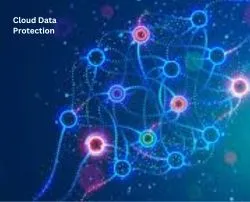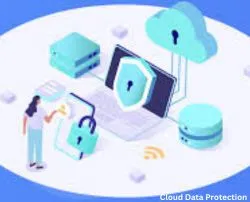Introduction
Cloud Data Protection has become a necessity as cloud-based systems have taken over our workflows as a nice to have and is now a necessity.
We should tell the truth; cybersecurity is no longer a choice. It is the virtual equivalent of closing the front door at night. Any click, download or file that you store in the cloud might end up being a playground of the hackers.
As a freelancer saving up files or a company holding on to customer data, the security of cloud data is your immediate defence.
What is evolving in the cybersecurity world then? Now, we are going to discuss the top 5 trends that are currently redefining the industry.
Trend 1: Cloud Data Protection Becomes a Top Priority

What Is Cloud Data Protection?
This is why you can consider Cloud Data Protection as the online version of the bodyguard to your sensitive files in the cloud. It is about securing, copying, managing and overseeing access to the information you have kept in cloud storage like Google Drive, AWS or Azure.
Why It’s Dominating the Cybersecurity Conversation
The reason why it is taking over the cybersecurity discussion.
Hackers have levelled up. Days of guessing with a password are gone. The current cybercriminals are against:
- Cloud misconfigurations
- Unsecured APIs
- Poorly protected backups
Indeed, the number of cloud vulnerabilities in 2024 led to more than 45 percent of data breaches. That is not a stat – it is a wakeup call.
Best strategies of Stronger Cloud Data Protection
- End-to-end encryption- even the cloud providers should not access your data.
- Role-based access control (RBAC)
- Logging and monitoring should be allowed to help identify suspicious activity.
- Conduct frequent cloud data backups not to become hostages of ransomware.
The takeaway? Cloud Data Protection is not only the reserve of techno geeks, but also of every other individual who values their privacy and peace of mind.
Trend 2: AI and Machine Learning in Cybersecurity

How AI Detects Threats Before They Strike
The concept of having a security guard who never sleeps and who analyses millions of threats per second is a reality. That’s AI in cybersecurity. These tools learn trends and report abnormalities such as attempts of logging into an insecure location or suspicious data transfers.
Pros and Cons of Using AI for Security
Pros:
- Super-fast detection
- Minimal manual effort
- Scales with your business
Cons:
- False positive may be vexing.
- Hackers are using AI too (uh-oh!)
- Small teams may be costly.
Real-Life Use Cases of AI in Cloud Data Protection
- Microsoft Defender is upgraded to detect insider threats in real-time with the use of AI.
- Darktrace uses machine learning to change its cloud protection according to user behavior.
- Google Chronicle is an analysis of cloud infrastructure threat telemetry.
Breaking point: AI plus Cloud = a potent cybersecurity combination, at least when applied intelligently.
Trend 3: Rise of Zero Trust Architecture (ZTA)

What Is Zero Trust?
Simply put, Zero Trust is of the view that you should never trust, but always verify. There is no automatic access of a device, a user or an app even when it is within your network.
How It Enhances Cloud Security
The cloud is borderless and dynamic thus ZTA is an ideal fit. Here’s why:
- Every request is verified
- Micro-segmentation minimizes the effects of breaches.
- Threats are kept in check by continuous monitoring.
Getting Started with ZTA
- Single Sign-On (SSO) is to be used to provide a frictionless and secure login.
- Incorporate identity providers (IDP) such as the Cloud Azure AD or OKTA.
- Separate your cloud environments- do not keep all your eggs in the same basket.
To be frank, Zero Trust would be the best friend of Cloud Data Protection.
Trend 4: Multi-Factor Authentication (MFA) Goes Mainstream

Why Passwords Alone Aren’t Enough
It is like putting your house under a shoelace in 2025 with password123. Hackers have means of breaking down passwords that are weak in just a few seconds.
MFA Tools That Help Cloud Data Protection
- Google Authenticator
- Authy
- Yubico Keys
- Microsoft Authenticator
These applications serve as handshakes which provide the second layer of protection that your cloud-stored information badly needed.
Balancing Security and User Convenience
Admittedly, MFA may pass as a speed bump. However, at the same time, a speed bump is more preferable to a ransomware roadblock, right?
Pro tip: Use app-based authentication as opposed to SMS. It is safer and it is equally quick.
Trend 5: Endpoint Security Gets Smarter

Defending Devices in a Remote Work World
Remote work is here to stay and each laptop or smartphone is a prospective breach point by the criminals. The devices are guarded with endpoint security tools wherever they may be.
Cloud-Connected Devices: New Attack Surfaces
Every device that is cloud-synced (supposedly Google Drive or Dropbox is auto-synced) adds risk. This is the reason why endpoint protection has developed to:
- Detect cloud sync anomalies
- Remote implementation of security updates.
- Restrict the use of USB/external drives.
Endpoint Protection Tools You Should Know
- CrowdStrike Falcon
- Bitdefender Gravity Zone
- Sentinel One
Consider endpoint security an armour of your personal body to your devices, which is indispensable to Cloud Data Protection.
Emerging Bonus Trends You Can’t Ignore

Cybersecurity-as-a-Service (CSaaS)
You do not need to develop a complete security team. Solutions such as CSaaS allow you to rent security such as Netflix- an option of paying as you use, expanding as you evolve.
Regulatory Compliance and Cloud Governance
Regulations such as GDPR and CCPA are currently dictating on the way businesses should store and secure cloud data. Non-compliance = big fines.
Threat Intelligence Sharing
Cyber defence has become a group game. Firms are also cooperating to exchange real time threat information and keep up with attackers.
Conclusion
Cybersecurity is not a technical buzzword it represents your initial line of defence in the madness that is the new digital west. And with the cloud as a new standard, Cloud Data Protection has to be your personal obsession.
The trends guarantee that its AI tools are sniffing threats or that its Zero Trust is blocking attempts to access dubious access routes, these trends are your roadmap to safer digital lands. Begin small, be on the lookout and do not wait till you are hacked to make this stuff important.
FAQs
1. What is the biggest cybersecurity threat in 2025?
The most frequent ones are cloud misconfiguration and phishing attacks. However, AI-based frauds and insider attacks are rapidly following.
2. How can I improve my cloud data protection today?
Use passwords that are hard to crack, use MFA, restrict user access and encrypt sensitive files. Such tools as Google Workspace and Microsoft 365 have inbuilt features to assist.
3. Is AI a safe technology for cybersecurity?
Yes—when deployed wisely. It only has to be checked and confirmed and utilized to the best of ethical use.
4. How does Zero Trust compare to traditional firewalls?
Firewalls believe in what is on the inside. Zero Trust checks it all in or out. It is like charging everybody at your party even your cousins.
5. Are free MFA tools effective enough for small businesses?
Absolutely. Such tools as Google Authenticator and Microsoft Authenticator are free and trustworthy and a no-brainer when it comes to the small teams.






